#messel pit
Explore tagged Tumblr posts
Text
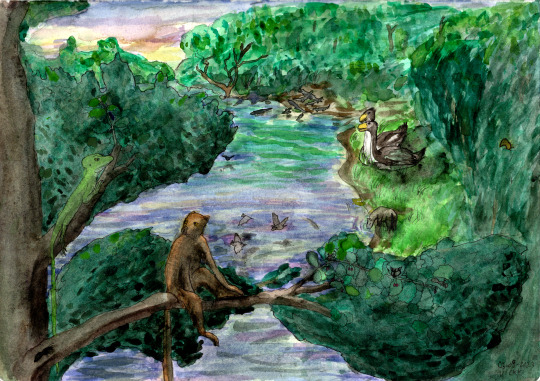
On a lovely evening 47 million years ago, Darwinius and Geiseltaliellus are forced to share their favourite lakeside tree. They do not particularly enjoy each other's company, but are unlikely to do something about it. Their tree has also become the grave of a couple of Titanomyrna infected with a cordycipitoid fungus, the giant ants spreading the fungus in their death grips. Meanwhile, a pair of Gastornis enjoys the evening Sun while a Eurohippus takes a drink, safe in the knowledge that these giant birds are herbivores. Archaeonycteris hunt insects above the lake, while various crocodylians hang out and get ready for the night.
#darwinius#geiseltaliellus#gastornis#eurohippus#titanomyrna#cordyceps#archaeonycteris#eocene#paleogene#paleoart#palaeoblr#my art#kopidodon#messel pit#adapiform#primate#mammal#corytophanid#lizard#squamate#bird#equid#perissodactyl#ant#insect#cw: bugs#cw: parasites#bat#crocodylian#i think that's everyone
59 notes
·
View notes
Text

Fossil Novembirb: Day 9
A male Primozygodactylus attempts to court a female
25 notes
·
View notes
Text
Hmmm… i'm going to say… Messel Pit?
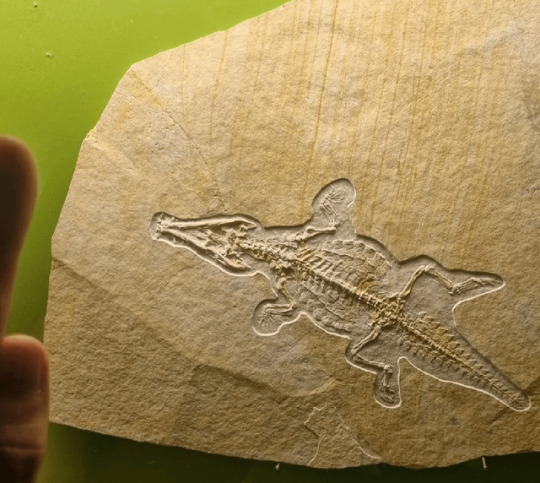
The fossil of a 20cm baby crocodile from Germany.
27K notes
·
View notes
Text
Germany 2023: Volcanoes & Famous Fossil Sites
We returned to Germany in 2023 to run our “Volcanoes & Famous Fossil Sites” tour. This round-trip from Frankfurt takes in some world famous fossil specimens as well as volcanoes, meteor impact craters and ancient caves! For this trip, we were joined by guests from the UK and Ireland – unusually, six of our group already knew each other, as they were all members of the Irish Geological…

View On WordPress
#archaeopteryx#caves#fossil#Fossils#frankfurt#geology#geology holiday#geology tour#geopark#geotour#geotourism#Germany#ice age caves#messel pit#museums#volcano#Volcanoes#World Heritage Site
0 notes
Text
Messel Pit Fossil Site

Today, we're embarking on a journey to the UNESCO World Heritage Site of the Messel Pit Fossil Site in Germany, where the secrets of Earth's ancient past are preserved in remarkable detail, waiting to be discovered.
The Messel Pit Fossil Site is a paleontological paradise that provides a glimpse into life on Earth 47 million years ago during the Eocene epoch. It's like a time capsule from a distant past.
In 1995, this site was granted UNESCO World Heritage status, recognizing its extraordinary scientific and historical significance. It's a place where fossils tell the story of evolution and the environment in vivid detail.

What makes Messel truly unique is the remarkable state of preservation of its fossils. The fine-grained oil shale has preserved not only the bones but also soft tissues, feathers, and even the contents of stomachs.
The Messel Pit is a treasure trove of prehistoric life. Fossils include early mammals, ancient reptiles, early primates, and a wide variety of plant life, offering a comprehensive view of Eocene ecosystems.
The site has been instrumental in our understanding of the evolution of mammals, birds, and insects. Fossils like the Eocene horse Propalaeotherium and the ancient crocodile Baryphracta becki are just a couple of the many remarkable discoveries.
The Messel Pit is not just a place for excavation but also for scientific research and conservation efforts to ensure the continued preservation of its valuable fossil record.
Messel is a place of learning and discovery, hosting events, exhibitions, and educational programs that celebrate the rich scientific heritage of the site.
In conclusion, the Messel Pit Fossil Site is a gateway to Earth's ancient past, offering a remarkable view of prehistoric life and evolution. As a UNESCO World Heritage Site, it invites us to appreciate the significance of paleontology and the remarkable stories fossils can tell. When you're ready to explore a world where time is frozen in stone, the Messel Pit is a destination that promises to inspire and captivate. 🌍🦕🔍
#messel#pit#fossil#culture#germany#europe#unesco#world heritage#discovery#ancient#travel#paleontology#past
1 note
·
View note
Text

Apatemyids were a group of unique early placental mammals that lived during the first half of the Cenozoic, known from North America, Europe, and Asia. Due to their specialized anatomy their evolutionary relationships are rather murky (they were traditionally part of the convoluted mess that was "Insectivora"), but currently they're thought to be a very early offshoot of the Euarchontoglires, the branch of placentals that includes modern rodents, lagomorphs, treeshrews, colugos, and primates.
Living in what is now western Europe during the mid-Eocene, around 47 million years ago, Heterohyus nanus was a small apatemyid about 30cm long (~12") – although just over half of that length was made up of its tail.
Like other apatemyids it had a proportionally big boxy head, with large forward-pointing rodent-like incisors in its lower jaw and hooked "can-opener-shaped" incisors in its upper jaw.

Example of an apatemyid skull from the closely related American genus Sinclairella. From Samuels, Joshua X. "The first records of Sinclairella (Apatemyidae) from the Pacific Northwest, USA." PaleoBios 38.1 (2021). https://doi.org/10.5070/P9381053299
The rest of its body was rather slender, and fossils with soft tissue preservation from the Messel Pit in Germany show that it had a bushy tuft of longer fur at the end of its long tail.
But the most distinctive feature of apatemyids like Heterohyus were their fingers, with highly elongated second and third digits resembling those of modern striped possums and aye-ayes. This suggests they had a similar sort of woodpecker-like ecological role, climbing around in trees using their teeth to tear into bark and expose wood-boring insect holes, then probing around with their long fingers to extract their prey.
———
NixIllustration.com | Tumblr | Patreon
References:
Kalthoff, D. C., W. Von Koenigswald, and C. Kurz. "A new specimen of Heterohyus nanus (Apatemyidae, Mammalia) from the Eocene of Messel (Germany) with unusual soft part preservation." Courier Forschungsinstitut Senckenberg 252 (2004): 1-12. https://www.researchgate.net/publication/263714512_A_new_specimen_of_Heterohyus_nanus_Apatemyidae_Mammalia_from_the_Eocene_of_Messel_Germany_with_unusual_soft-part_preservation
Koenigswald, W. V., and H-P. Schierning. "The ecological niche of an extinct group of mammals, the early Tertiary apatemyids." Nature 326.6113 (1987): 595-597. https://www.researchgate.net/publication/232761846_The_ecological_niche_of_early_Tertiary_apatemyids_-_extinct_group_of_mammals
Samuels, Joshua X. "The first records of Sinclairella (Apatemyidae) from the Pacific Northwest, USA." PaleoBios 38.1 (2021). https://doi.org/10.5070/P9381053299
Silcox, Mary T., et al. "Cranial anatomy of Paleocene and Eocene Labidolemur kayi (Mammalia: Apatotheria), and the relationships of the Apatemyidae to other mammals." Zoological Journal of the Linnean Society 160.4 (2010): 773-825. https://doi.org/10.1111/j.1096-3642.2009.00614.x
#science illustration#paleontology#paleoart#palaeoblr#heterohyus#apatemyidae#apatotheria#euarchontoglires#mammal#art#convergent evolution#exceptional preservation#it's like if a rat tried to become an aye-aye
209 notes
·
View notes
Text

My 25 years of palaeoart chronology...
In 2020 I illustrated LOCKED IN TIME, written by Dr Dean Lomax. Here's my greyscale painting of a pair of mating Messel Pit (47Ma) turtles.
This book would make a great Christmas gift! https://cup.columbia.edu/book/locked-in-time/9780231197281
#Art#Painting#PaleoArt#PalaeoArt#SciArt#SciComm#DigitalArt#Illustration#Dinosaurs#Birds#Reptiles#Palaeontology#Paleontology
27 notes
·
View notes
Text
Fossil Novembirb 11: A New Dawn

Palaeotis by @drawingwithdinosaurs
One of the absolutely best known ecosystems of the Eocene is found at the Messel Pit site of Germany. Deposited in a similar way (via multiple volcanic eruptions over periods of thousands of years) to the Fossil Lake of yesterday, but a few million years later, it shows the end of the early Eocene and the start of the emergence of modern mammalian groups. Lucky for us, it also shows the next stage of bird evolution! This was also the site featured in the first episode of Walking With Beasts, "A New Dawn", though the avifauna was not particularly well represented in that program.
Yes, obviously, Gastornis was in Messel, though as a large ground herbivore than a predator. But there were plenty more birds than that! Lithornis was also here, because it was just as ubiquitous; and there was also the mysterious Palaeoganth Palaeotis. Originally thought to be a relative of Ostriches, then not, and now possibly again, this bird has a strangely intermediate morphology between that of large flightless Palaeognaths and the Lithornithids of the early Paleogene; indicating it may be a transitional form. It would not have been able to fly, given its short wings and lack of keel, and probably fed on small animals in its environment.

Juncitarsus by @thewoodparable
In addition to the Megafowl Gastornis, there was also the early landfowl Paraortygoides, which did not have a crop like living landfowl and as such probably mainly fed on soft plant material. It also had shorter legs than other landfowl relatives at the time, indicating it may have been more similar to living pheasants than fowl that had been around previously.
Even though the Flamingo-Ducks like Presbyornis would stick around well into the Neogene, the first relatives of Flamingos show up at around this time. Juncitarsus was a wading bird, probably just as closely related to living grebes as their cousins flamingos, and had gastroliths in its stomach - allowing it to feed on hard animals it gathered in from the lake. It wasn't the only wader; Messelornis, a wader related to living rails and cranes; is the most common bird at the Messel Pit and was an important generalist in its ecosystem. In addition, the "Snipe-Rail" Rhynchaeites was actually an ibis relative, probing for food with its beak in the substrate around the lake.
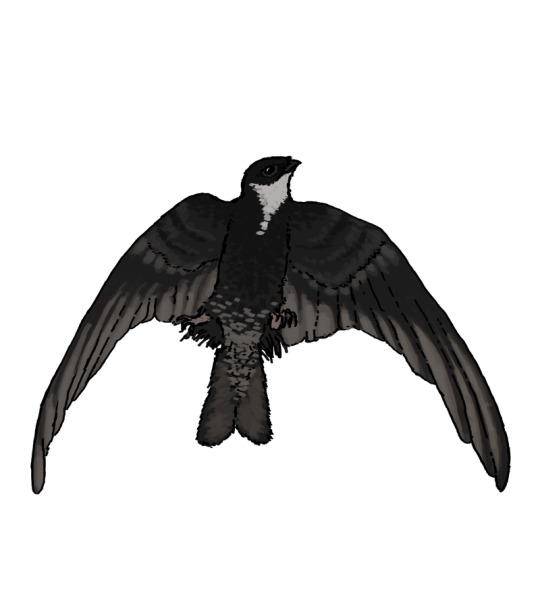
Scaniacypselus by Paleo Miguel
Strisores are everywhere at Messel, with relatives of swifts and hummingbirds like Cypseloramphus, Parargornis, and Scaniacypselus, which weren't as adapted to specialized aerial niches as their living relatives. An insectivore with tiny feet, Protocypselomorphus, was also present; as were an early potoo in the form of Paraprefica and an early frogmouth in the form of Masillapodargus.
Strange flight specialists far away from their living ranges aren't the only bizarre features of the ecosystem - Masillastega, a piscivore and relative of living gannets and boobies, was also present at Messel. More relatives of seriemas, like Dynamopterus, Salmila, and Strigogyps showcase how not all Cariamiformes were predators - Strigogyps was an herbivore! The long-legged predator Masillaraptor was present there too, indicating falcons were successful as multiple types of raptors prior to today. The owl Palaeoglaux was a small predatory bird, with ribbon-like feathers in dense layers on its back.
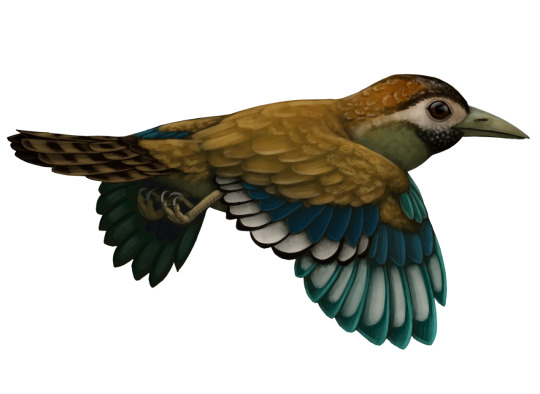
Eocoracias by @drawingwithdinosaurs
There were, of course, many tree dwelling birds in this lacustrine forest, including relatives from both sides of the "core landbirds" family tree. The ecosystem preserves a truly alarming number of mousebirds, including Chascacocolius with a conical beak, and Eoglaucidium with a strangely short tail. Eocoracias, another early roller like those found in Denmark, had iridescent feathers. Early hoopoes like Messelirrisor and early trogons like Masillatrogon show even more examples of more tropical birds showing up in higher latitude locations during this warm period. Messelastur was another possible Parrot/Passerine of prey; as was possibly Pumiliornis. Tons of pre-Passerines were here, too, including the zygodactly-footed Serudaptus, Psittacopes, and Primozygodactylus.
These dinosaurs were living at the end of a time of rapid evolution and diversification for most living things on Earth. However, the hot and humid times never last - as the planet begins to cool, drier ecosystems spread around the planet, and the global tropical forests fade into obscurity. It's time for these new groups of dinosaurs to adapt for new ecosystems...
Sources:
Mayr, 2022. Paleogene Fossil Birds, 2nd Edition. Springer Cham.
Mayr, 2017. Avian Evolution: The Fossil Record of Birds and its Paleobiological Significance (TOPA Topics in Paleobiology). Wiley Blackwell.
Smith, K. T. 2021. The Messel Pit: Window into a Greenhouse World. Geoconservation Research 4(2): 547-556.
118 notes
·
View notes
Text
Fossil Novembirb: Day 13
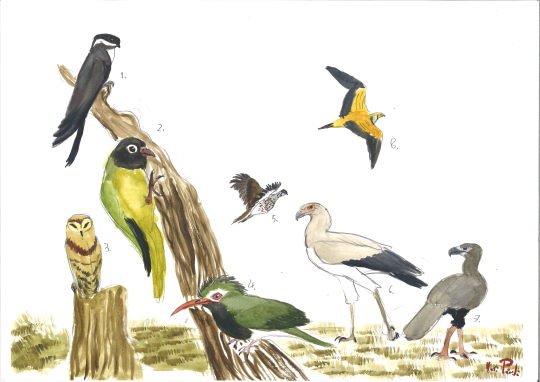
The phosphorate beds of Quercy, France preserve a wealth of fossils from the late Eocene and Oligocene epoch, about 35-25 million years ago. At that time, the early Paleogene jungle hothouse had ended. The climate was drying and cooling, and in parts of the world forests were giving way to savannah and scrubland, as was in Quercy. But that didn't stop birds. They started to take advantage of these new wide open spaces.
Aegialornis: An enigmatic bird that was closely related to swifts. Unlike swifts, it could perch and hold on to branches, but it was also an incredible flyer.
Quercypsitta: A unique group of not well known stem-parrots which likely resembled the earlier Halcyornithids, corvid-like stem-parrots from Europe and North America.
Palaeoglaux: Also known from the Messel Pit, this early relatively small owl may have been a diurnal hunter of small prey and had peculiar body feathers.
Sylphornis: A mysterious member of the piciformes with unique morphology, resembling jacamars and puffbirds.
Paraortyx: One of the earliest true phasianid galliforms, related to partridges, pheasants and chickens. It likely had a similar lifestyle to them, only taking flight when necessary.
Pelargopappus: An early relative of the long-legged secretarybird, this Eocene relative stalked the plains in a similar manner, stomping down on any prey it could catch.
Strigogyps: An omnivorous turkey-sized member of the cariamiform family, it is also known from the middle Eocene of Germany.
Archaeoganga: A relatively large and one of the earliest members of that wonderful desert bird clade, the sandgrouse.
#Fossil Novembirb#Novembirb#Dinovember#birblr#palaeoblr#Birds#Dinosaurs#Cenozoic Birds#Aegialornis#Quercypsitta#Palaeoglaux#Sylphornis#Paraortyx#Pelargopappus#Strigogyps#Archaeoganga
37 notes
·
View notes
Text
Multituberculate Earth: Messel Pit


Messelboffius atraxa, a red-kangaroo sized hopper from the Eocene of Europe, coupled with its muscular anatomy. By Dr Spooky.
The Messel Pit is a world renowed (being even a UNESCO heritage site) fossil site in Germany, dating to the Lutetian stage of the Eocene. It represents a lake environment associated with a volcano, the latter likely providing toxic gases that routinely killed the local fauna (such events have been compared to our timeline’s Lake Nyos incidents). The lake likewise had an anoxic layer preventing normal decomposition by bacteria; as a result, animals that fell into the lake’s deeper regions became exceptionally well preserved. Soft tissues from hair to organs are known, all captured within thin limestome slabs.
The climate in the region was tropical; in this timeline, perhaps even hotter thanks to an extended thermal maximum. Tropical rainforests covered what was once an island continent, as Europe was isolated from the other landmasses. This allowed it to develop an unique fauna with elements from both Laurasia and Gondwanna.
Taeniolabidids were the largest land mammals in the continent, though european forms were mostly island dwarfs; the local Gauliolabis messelnienses, the very largest land mammal in the site, rarely surpassed 120 kg. It was a semiaquatic herbivore, though more closely related to north american giants than to other aquatic forms. The second largest mammal was Messelboffius atraxa, a boffiid, about as large as a red kangaroo at 47 kg, and similarly a hopper much like most of its relatives.
No, the largest land animal was not a mammal but rather the famous flightless bird Gastornis. Europe, much like in our timeline, had birds as the largest land animals, making it rather similar to Madagascar in our timeline’s Pleistocene, being another island continent ruled by giant birds. Terrestrial crocodilians like Bergisuchus and Boverisuchus were the apex predators on land, with more familiar forms ruling the waters. It was truly a reminder of the age of the dinosaurs.
Still, some mammals packed a punch. Celtoptilodus giganteus was a bobcat sized ptilodontoid and the largest mammalian carnivore in the region, followed closely by the symmetrodont Taranomamus horridus, a more robust and badger like animal. Ptilodontoids and symmetrodonts occupied the main carnivorous and omnivorous niches among mammals, and though several species were small (particularly symmetrodonts) their menagerie was vast. Another common group of omnivores were the eucosmodontids; though many forms were terrestrial mouse to cat sized species, the Messel Pit preserves two genera of flyers: Khusuurbaatar, with wings supported by its styliform, and Plummobaatar gaulica, with wings composed of feather-like hairs.

Khusuurbaatar elegans by Dave García. One of various flying euscosmodontid lineages, this one lasted across the Eocene, with fossils found in Asia, Europe, North America, Australia and Antarctica. It was a genus of fast aerial insectivores, this species being the largest known with a wingspan of 60 centimeters.
Another flyer was the ptilodontoid Pteroectypodus falco, which also occured in contemporary sites in North America. This diversity of flying mammals rivals our timeline’s bat diversity, of which several species are known from the Messel Pit.

Pteroectypodus falco by Diego Ortega Anatol.
Among herbivorous mammals, the most common were the gondwanathere feruglitheriids, which likely arrived to Europe from North America (and in turn from South America) in the Paleocene. They and the boffiids compromised the main herbivorous guilds: the ferugliotheriids ranged from mouse sized to 50 kilo large forms, from burrowers to sloth-like tree climbers, while boffiids were more typical hoppers, ranging from jerboa sized to the aforementioned Messelboffius atraxa.
Microcosmodontids were smaller in Europe than in other land masses, the largest being the mole-sized burrower Velesotherium occidentalis. The eucosmodontid Thylacolutra messeliensis occupied an aquatic forager niche akin to an otter, while the ptilodontoid Amaxillodens plagiaulacoides lost its upper dentition, relying on its plagiaulacoid teeth and robust claws to open termite nests.
The unique fauna of the Messel Pit is a slice in time of when Europe was allowed to develop its fauna in isolation. With the Grand Coupure, climatic changes and competition from arrivals from Asia ended this strange world. But for almost twenty million years, the fauna of Europe thrived in their tropical island paradise.
10 notes
·
View notes
Text

Fossil jewel beetle, still showing the colour of the exoskeleton. Messel pit, Germany.
50 notes
·
View notes
Text
My art in 2023
January
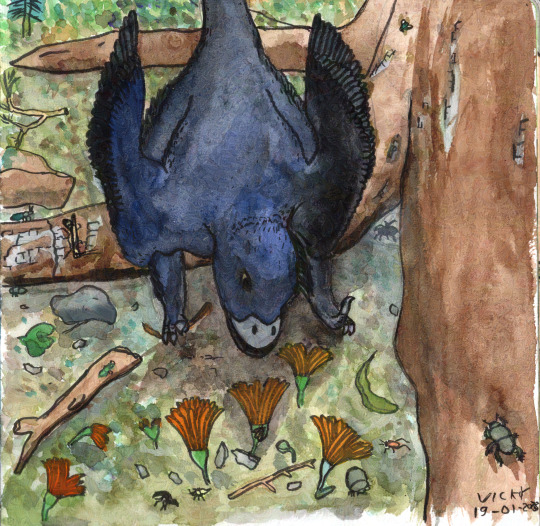
Microraptor and the Flowers. I started this year out making paleoart watercolours and never really stopped. This one is about a Microraptor investigating the first flowers she's ever seen. The flowers are Lingyuananthus, a lovely little fossil flower described in an even lovelier paper that was not behind a paywall for once.
February

Orthocones Descend. Having moved into a new apartment and made a timeline covering the walls, the paleozoic looked awfully empty, so I made a big effort to expand my horizons and do art showing creatures I'd never drawn before. Showing orthocones descending vertically on their prey made for a fun composition too.
March

Sinosauropteryx does not want to share its tree. I still can barely believe we know the colours of both Sinosauropteryx and Psittacosaurus. Dinosaur colours always felt like something we'd never figure out without literal actual time travel before we figured them out.
April
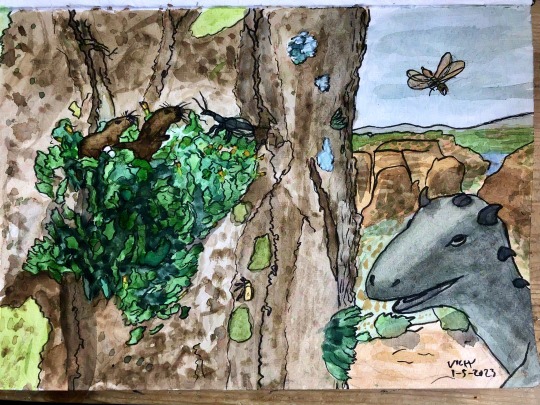
Hadrocodium's mossy home. I got the idea for one of the tiniest mammals of all time making its home in some moss on a tree while hiking in Switzerland and coming across some truly impressive moss beards.
May
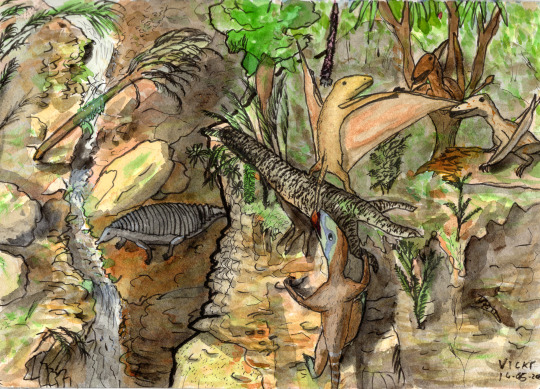
Procompsognathus's cliff climb. Although the foreground cliff itself and the contrast between foreground and background didn't come out quite as well as I'd hoped, I still really like this art featuring the three main branches of archosaur (dinosaur, pterosaur, and pseudosuchian).
June

Anomalocaris, Dragon of the Cambrian. The realisation that most Cambrian creatures were tiny gave me the idea of a whole bunch of them hiding from a 40 cm long Anomalocaris while in positions reminiscent of a D&D party facing off against a dragon.
July
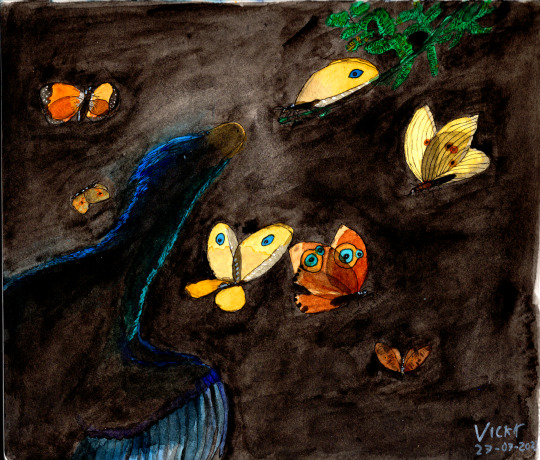
Caihong and the Kalligrammatids. Kalligrammatids were neuropterans that superficially resembled large butterflies, but unlike them their wings were transparent! I combined them with the gorgeous iridescence of Caihong and backlighting for a fun experiment.
August
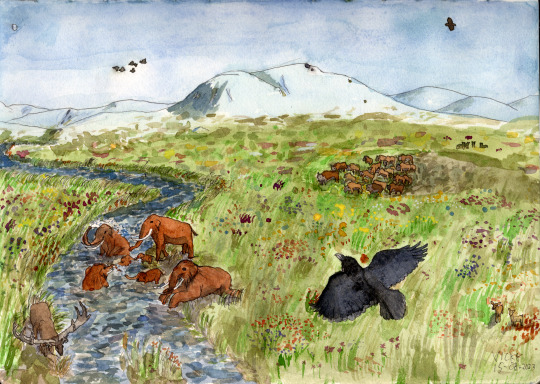
Spring on the mammoth steppe. When the time came to do some art set in the Quaternary, I decided to depict a real life location and how it would have changed in the past few hundred thousand years. This spot is just west of Baden-Baden (which is in the glacier valley to the upper left), on the edge of the Schwartzwald. I also enjoyed depicting an ice age spring. It wasn't always snow and ice.
September
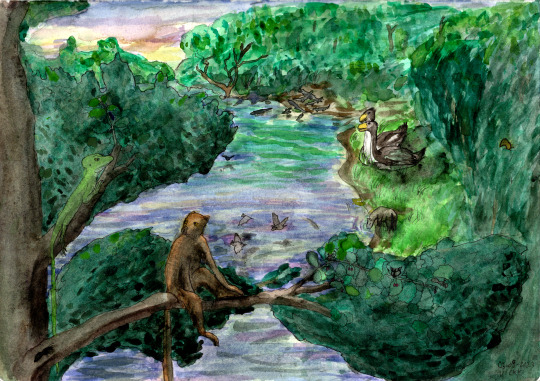
Darwinius and Geiseltaliellus's stare-off. The Paleogene was the last remaining Phanerozoic period I hadn't done any art of, so I drew this little scene in the Messel Pit formation.
October

Inostrancevia family at sunrise. I hadn't drawn Permian synapsids in a while at this point so they were overdue for a paleoart. I also felt like going absolute ham with my reds. The sunrise and Permian volcanism made for a convenient excuse but really, this is just for me.
November
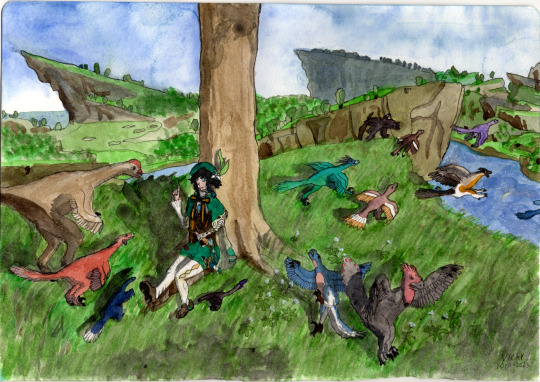
Wind, Courage, and Wings. This one's a birthday gift for my friend, depicting a lovely fable in Genshin Impact about how the wind god Barbatos taught the first birds to fly.
December

The Zanclean Flood. 6 million years ago, the movement of the continents cut the Mediterranean off from the oceans. Since more water evaporates from the Mediterranean than it receives from rivers, this resulted in the sea drying up and becoming an incredibly deep, dry, salty lowland. Until 5.3 million years ago, when the Strait of Gibraltar formed and the entire sea was refilled in a massive flood. This depicts the early days of said flood seen from the tip of the Rock of Gibraltar.
If you've enjoyed my art this year, consider leaving me a tip! Or have a look at last year's art too.
#paleoart#my art#palaeoblr#2023#my art in 2023#watercolour#definitely not gonna tag every creature appearing in these#cw: bugs
52 notes
·
View notes
Text


Fossil Novembirb: Day 11
Dawn in Messel
1. Eocoracias brachyptera
2. Masillastega rectirostris
3. Juncitarsus merkeli
#paleoart#prehistory#fossil novembirb#messel pit#eocoracias#masillastega#juncitarsus#made with krita
9 notes
·
View notes
Text

In the Messel Pit exhibit at the Senckenberg Museum they had this enormous ant, Titanomyrma. I'm guessing this is what that scene from Walking With Beasts with the giant ants eating the terror bird's chick is based on.
20 notes
·
View notes
Text
The Big Bang of Tertiary Birds
New Post has been published on https://petn.ws/jW26b
The Big Bang of Tertiary Birds
Photo; Haplochromis, CC BY-SA 3.0 , via Wikimedia Commons. This Fossil Friday we look into the abrupt origin of birds, which is just one of the many discontinuities in the fossil record of life on Earth. The image features a fossil bird of the genus Rhychaetites from the famous Eocene Messel pit in Germany. It is similar […]
See full article at https://petn.ws/jW26b #BirdNews
0 notes
Text
instagram
For #WorldHeritageDay I decided to do a bunch of #twitter polls about what cultures and heritages you would like to explore? You can vote now on my twitter & i guess i can make ig polls in my stories if you ask nicely lol.
The United Nations Educational, Scientific & Cultural Organization (#UNESCO) seeks to encourage the identification, protection & preservation of cultural & natural heritage around the world considered to be of outstanding value to humanity.
Lots of these places I've never heard of so here's some examples:
* major cities/hotspots to visit include - Quito, #Ecuador: the capital & best preserved, least altered historic centre in #LatinAmerica; Spa Towns of #Europe: located in 7 different countries; Salvador de Bahia, #Brazil's first capital; Nice, French Riviera which is devoted to winter tourism; Azores, #Portugal: with ports to Africa & East/West Indies
* holy sites to visit - Santiago Routes, #Spain: most influential route that connects different peoples of Europe; Sacri Monti, #Italy: sacred landscapes made of art, sculpture & nature; St James Cathedral, #Croatia: where Gothic & Renaissance meet; Bom Jesus do Congonhas, Brazil: filled with Baroque masterpieces; Chartres Cathedral, #France: the model of Gothic architecture; Jesuit Missions in #Paraguay: fusions of culture amongst archaeological ruins; #SanAntonio Missions Park, USA: largest collection of Spanish colonial missions in USA
* nature sites - Colchic Rainforests, #Georgia: forests that survived the #IceAge!; Jeju Volcanic Island, #SouthKorea: volcanic museum; Paseo del Prado, #Madrid: a landscape of arts & sciences; Blue & John Crow Mountains, #Jamaica: get lost in the "Elfin Forest"; Messel Pit, #Germany: a treasure trove of fossils throughout Earths history
* historical sites - explore pyramids in #Egypt & #Sudan; Hegra, #SaudiArabia: remote ancient city with rock carved tombs; #Pompeii, Italy; Palace of #Versailles; Buckingham Palace & #Stonehenge, UK; #ShintoShrine, #Japan
you see anything that's been on your bucket list? #mixedheritage #mixedhistory
0 notes